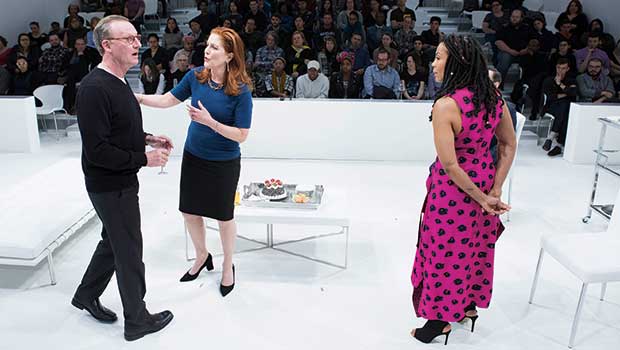‘The White Card’
Claudia Rankine play holds a mirror up to white allies

Audiences of “The White Card,” produced by ArtsEmerson and the American Repertory Theater, are ushered into a sterile white cube constructed on the stage of the Paramount Theatre. Seats on both sides of the room flank a minimalistic living room where wealthy white art collectors Virginia and Charles (Patricia Kalember and Daniel Gerroll) host a dinner for up-and-coming black artist Charlotte (Karen Pittman).
On the web
For more information and to purchase
tickets to “The White Card,” visit:
The set alludes to the term “white cube” as slang for a gallery space. The cast and the audience are on exhibition. Charlotte, the artist, finds herself under the scrutiny of display lighting, and up for sale. As the evening progresses it becomes apparent that Virginia and Charles are unable to recognize the role their white privilege plays in the racial dynamic at hand, or in the current state of racial politics.
After each microaggression and cringe-worthy comment, Charlotte becomes more uncertain about working with the couple. As a black artist in a world of white patrons, she’s trying to find the middle ground between success, and selling her morality.
Virginia and Charles collect art about black deaths. Placing African Americans in the “victim” box allows them to feel superior and to calm their consciences. For the couple, activism only goes as far as the frames on the wall. Supporting black people is only about recognizing their wounds, not who put them there. Charlotte says, “Black people have always been dying and white people have just noticed they were doing the killing.”
That’s what Charlotte wants, for Virginia and Charles to recognize their own role, and acknowledge that owning a few Basquiat works doesn’t erase a complicated history.
Several times, Dana Schutz’s Emmett Till painting is mentioned. Schutz is a white artist who painted a portrait of Till’s corpse, a move that many deemed appropriative. In 2017, a group of Bostonians lobbied for the Schutz show at the ICA to be removed because of that history.
“The White Card” brings up crucial ways racism affects black artists. Charlotte comments that black art is always looked at through the lens of activism and oppression. There’s never a black landscape artist, only a black artist using the land as a symbol for persecution. Oppression becomes the identity in the analysis of black art.
Claudia Rankine’s play is particularly poignant in the Boston setting. The A.R.T. and ArtsEmerson audiences are primarily white. The house lights are kept on throughout the show because the audience is a crucial part of the performance. “The White Card” holds a mirror up to its patrons and asks, ‘Is this you?’







